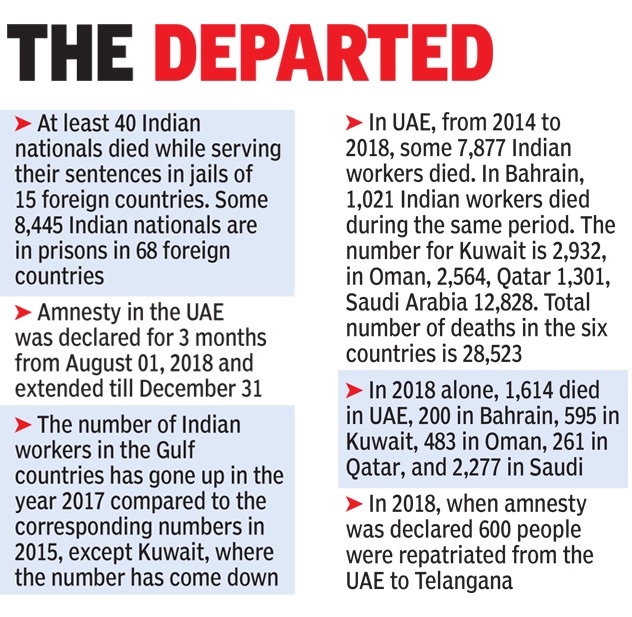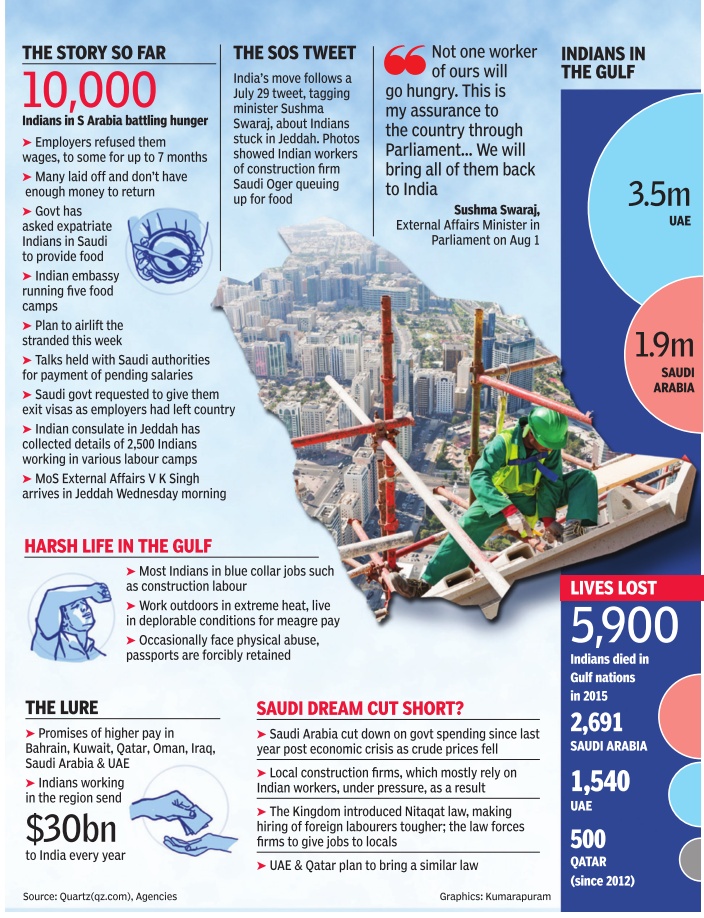Indians in the Gulf
(→Death of Indian workers in the Gulf ) |
(→Year-wise trends) |
||
| Line 45: | Line 45: | ||
''2015-16: the status of Indians in the Gulf'' | ''2015-16: the status of Indians in the Gulf'' | ||
| + | |||
| + | ==2019: Workers from Africa, Philippines replace Keralites== | ||
| + | [https://timesofindia.indiatimes.com/city/kochi/workers-from-africa-philippines-replace-keralites/articleshow/68349633.cms Shenoy Karun, March 11, 2019: ''The Times of India''] | ||
| + | |||
| + | |||
| + | A weakened economy of the Middle East and protectionist measures of the Indian Government results in the displacement of Indian labourers, especially the Malayalis in the Gulf, say experts in migration. | ||
| + | |||
| + | “The economy of Gulf hasn’t picked up after the global crisis. There is some recovery but haven’t got back to the pre-2008 level. They were trying to recover through World Cup, Dubai Expo 2020 and Saudi Arabia Vision 2020, but they are yet to reach the pre-2008 stature, said S Irudaya Rajan of Centre for Development Studies, Thiruvananthapuram. The wages haven’t gone up. But people from other countries like Nepal or the Philippines are ready to work for low wages, thus edging out Malayalais. I had met some Nepali labourers in Qatar, who are working for $200 (Rs 14,000) per month,” he said. | ||
| + | |||
| + | According to him, the salary of teachers in the Philippines was so low that they were coming to the Middle East to work as housemaids. | ||
| + | |||
| + | “This led to a situation where the Philippine Government had to match the teachers’ salary with that of housemaids in the Gulf to bring them all back,” he pointed out. | ||
| + | |||
| + | “Africa is becoming a big threat to Indian labourers, especially Malayalis,” said Majeed Abdulla, chairman of Resource Hunters, which supplies human resources to the Middle East. | ||
| + | |||
| + | “They have multi-skills and their language skills are also good, prompting firms to hire them. And they demand only a little above 50% of what you typically pay to an Indian worker,” he said. | ||
| + | |||
| + | The displacement is happening in professions like drivers, helpers and store workers. | ||
| + | |||
| + | “While Indian drivers demand more than Rs 20,000 per month, the African counterparts work for the equivalent of Rs 8,000 per month. Similarly, while Indian security staff demand Rs 30,000 the Africans are willing to work for Rs 20,000 per month,” Abdulla said. | ||
| + | |||
| + | A second factor for the displacement of Indian workers is the higher minimum wage fixed by the Indian government, said a Mumbai-based recruiting agency. | ||
| + | |||
| + | For example, the Indian embassy in Saudi Arabia has published the referral wage of unskilled workers as SR 1,500 (close to Rs 30,000). For the local Arab households and businesses, this proves to be expensive, because, apart from this the employer must provide food, accommodation, transportation, medical insurance, uniforms, paid leave and return ticket for the worker. | ||
| + | |||
| + | A third factor is the attempt of the Gulf countries to maintain a demographic balance. It also acts against the hiring of Indian/Malayali workers. | ||
=See also= | =See also= | ||
Revision as of 15:20, 16 March 2019
This is a collection of articles archived for the excellence of their content. |
Contents |
Death of Indian workers in the Gulf
2014-18
Raising serious questions about the safety of Indian labourers working in the Gulf countries — Bahrain, Kuwait, Oman, Qatar, Saudi Arabia and the United Arab Emirates — the external affairs ministry said 28,523 Indians working as labourers in these nations died there between 2014 and 2018.
To a question by Lok Sabha member from Patiala, Dharamvira Gandhi, minister of state for external affairs, VK Singh, said according to data compiled by Indian embassies in these countries, most deaths were from Saudi Arabia where 12,828 unskilled Indians died since 2014, followed by United Arab Emirates where 7,877 died till 2018.
Hundreds from Telangana die in the Gulf every year
U Sudhakar Reddy, January 29, 2019: The Times of India

From: U Sudhakar Reddy, January 29, 2019: The Times of India
A 24-year-old tribal farmer Ganesh Badhavath of Kottakortula Tanda in Nallavelli in Nizamabad district ended his life in Bahrain on January 13, by hanging himself, 20 days after his legal migration on a work visa. He leaves behind his pregnant wife and a two-year-old daughter. Debts due to failed borewells, money paid to the agent who obtained visa, and the stress of staying away forced him to take the extreme step.
Ganesh’s father Devi Singh told TOI, “All the four borewells dug in the one acre of land owned by Ganesh failed. He could not pay his debt of Rs 3 lakh. Ganesh had paid Rs 60,000 to an agent and got a visa in December 2018. He left for Bahrain on December 18 after being recruited by a Tamil Nadu-based agency and started working in Almoran as a cleaner for Rs 18,000 salary per month. He was able to get a visa as he had been there earlier, and had returned. We didn’t get Rythu Bandhu for the land, and Ganesh was not eligible for Rythu Bima as the land is an assigned land according to government officials.”
Ganesh’s story is not an isolated case, as lakhs of people migrate for a meagre salary of Rs 10,000 to Rs 25,000 depending on the country. The cost of living in most Gulf countries is high. Telangana is one of the top five states reporting a large number of deaths due to suicide, work site accidents, road traffic accidents and cardiac arrests. As many as 28,523 Indians died in six Gulf countries + in the past four years.
Cheated in their search of a better life
They mostly belong to Uttar Pradesh, Bihar, West Bengal, Rajasthan, Punjab, Telangana and Andhra Pradesh. Most deaths are reported from Saudi Arabia and the United Arab Emirates. Harsh conditions, debts, cheating by agents, and family issues back home are the main reasons behind the suicides. Officially, as per 2017 statistics, as many as 22.53 lakh workers are living in the Gulf.
Telangana NRI wing official, E Chitti Babu, told TOI, “Since July 2014, we have officially helped to get around 518 bodies, where we offer free ambulance service to shift the bodies from the airport to their hometown for Below Poverty Line families. Unofficially, another 100 bodies may have arrived. Of these cases, around 30 are suicides. Most deaths are attributed to heart attacks due to harsh weather conditions, lack of proper food and sleep. In some cases, where a person injured in road accident gets admitted to hospital and dies, the hospital authorities declare it as cardiac arrest. This is done to avoid the payment of compensation of Rs 15 lakh, for which the worker is eligible.”
Year-wise trends
2015-16: the status of Indians in the Gulf

See graphic:
2015-16: the status of Indians in the Gulf
2019: Workers from Africa, Philippines replace Keralites
Shenoy Karun, March 11, 2019: The Times of India
A weakened economy of the Middle East and protectionist measures of the Indian Government results in the displacement of Indian labourers, especially the Malayalis in the Gulf, say experts in migration.
“The economy of Gulf hasn’t picked up after the global crisis. There is some recovery but haven’t got back to the pre-2008 level. They were trying to recover through World Cup, Dubai Expo 2020 and Saudi Arabia Vision 2020, but they are yet to reach the pre-2008 stature, said S Irudaya Rajan of Centre for Development Studies, Thiruvananthapuram. The wages haven’t gone up. But people from other countries like Nepal or the Philippines are ready to work for low wages, thus edging out Malayalais. I had met some Nepali labourers in Qatar, who are working for $200 (Rs 14,000) per month,” he said.
According to him, the salary of teachers in the Philippines was so low that they were coming to the Middle East to work as housemaids.
“This led to a situation where the Philippine Government had to match the teachers’ salary with that of housemaids in the Gulf to bring them all back,” he pointed out.
“Africa is becoming a big threat to Indian labourers, especially Malayalis,” said Majeed Abdulla, chairman of Resource Hunters, which supplies human resources to the Middle East.
“They have multi-skills and their language skills are also good, prompting firms to hire them. And they demand only a little above 50% of what you typically pay to an Indian worker,” he said.
The displacement is happening in professions like drivers, helpers and store workers.
“While Indian drivers demand more than Rs 20,000 per month, the African counterparts work for the equivalent of Rs 8,000 per month. Similarly, while Indian security staff demand Rs 30,000 the Africans are willing to work for Rs 20,000 per month,” Abdulla said.
A second factor for the displacement of Indian workers is the higher minimum wage fixed by the Indian government, said a Mumbai-based recruiting agency.
For example, the Indian embassy in Saudi Arabia has published the referral wage of unskilled workers as SR 1,500 (close to Rs 30,000). For the local Arab households and businesses, this proves to be expensive, because, apart from this the employer must provide food, accommodation, transportation, medical insurance, uniforms, paid leave and return ticket for the worker.
A third factor is the attempt of the Gulf countries to maintain a demographic balance. It also acts against the hiring of Indian/Malayali workers.
See also
Indians in the Gulf